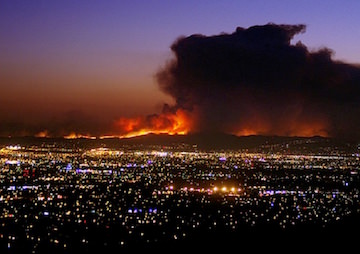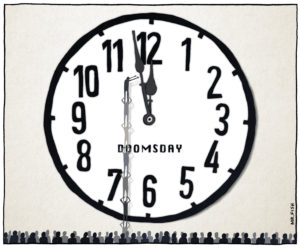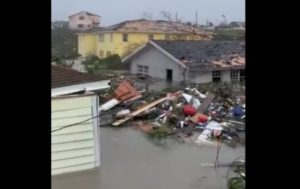U.S. Braces for Even Worse Wildfire Season
Years of drought and higher temperatures mean the chance of devastating wildfires in the southwest U.S. is higher than ever -- particularly in southern California.
By Kieran Cooke, Climate News Network

Forest fires rage in the mountains above the urban sprawl of Rancho Cucamonga, Calif. (Erik Nielsen via Flickr)
This Creative Commons-licensed piece first appeared at Climate News Network.
LONDON — The firefighters are primed, hoses at the ready. May and June are often the peak months for forest fires in the southwest of the US, and the outlook for this year is grim.
“I wish I could have some hope,” says Dr Wally Covington, director of the Ecological Restoration Institute at North Arizona University. “It’s just a terrible situation in southern California.”
Covington, an internationally recognised expert on forest restoration, says a prolonged drought, higher temperatures and stronger than usual winds mean big wildfires are inevitable across the southwestern US.
The main season for wildfires in the region has in the past been from mid-May through till late September, but now forest fires burn virtually year round.
Vulnerable landscape
“Climate change and misguided forestry policies have combined to present a landscape very vulnerable to devastating fires,” Covington told the Climate News Network.
“Since around 2000, we’ve seen more severe dry weather, matched with high winds throughout the western US. Intense firestorms are the result. Get in the vicinity of one of those and it’s like being near a blast furnace.”
Covington and other experts say it is vital that people and government policy adapt to the changes in climate.
Over the years, forests have been densely planted in many areas, and old forestry practices — such as clearing out forest and shrubland by regularly burning off old tree cover and dry shrubs — were stopped.
“We’ve just got to stop building in those places.
It was crazy 40 years ago — and it’s
even more crazy now”
The result is not only an abundance of dense forested areas where fire can build up and spread easily, but also accumulations of dried-out grasses and shrubs referred to as fine fuel.
Opening up forest areas and reintroducing controlled, periodic burning to rid the landscape of these tinder-dry fuels is key, according to Covington.
He says: “The US Forest Service now sees opening up forest areas and restoring them to what they once were — right across the US — as its primary goal. That’s a huge policy breakthrough.”
The past three years have been among the driest on record in California, and there are fears that the drought will continue.
Historic low
Wells have dried up in many areas, reservoirs in the state are at a record low, and the snowpack in the Sierra Nevada mountain range – vital for feeding water on to the lands below – is at an historic low for the time of year.
For the first time in California’s history, mandatory water restrictions have been brought in, with cities and towns required to cut water use by 25%.
This does not, however, apply to the state’s multi-billion dollar agricultural industry, which uses up to 80% of water supplies.
Besides the drought, strong winds and higher temperatures, other factors have increased the risk of wildfires across the region. For example, building houses in forest and shrubland areas has also increased the danger of fires being ignited.
“We’ve just got to stop building in those places,” Covington says. “It was crazy 40 years ago — and it’s even more crazy now.”
Your support matters…Independent journalism is under threat and overshadowed by heavily funded mainstream media.
You can help level the playing field. Become a member.
Your tax-deductible contribution keeps us digging beneath the headlines to give you thought-provoking, investigative reporting and analysis that unearths what's really happening- without compromise.
Give today to support our courageous, independent journalists.






You need to be a supporter to comment.
There are currently no responses to this article.
Be the first to respond.